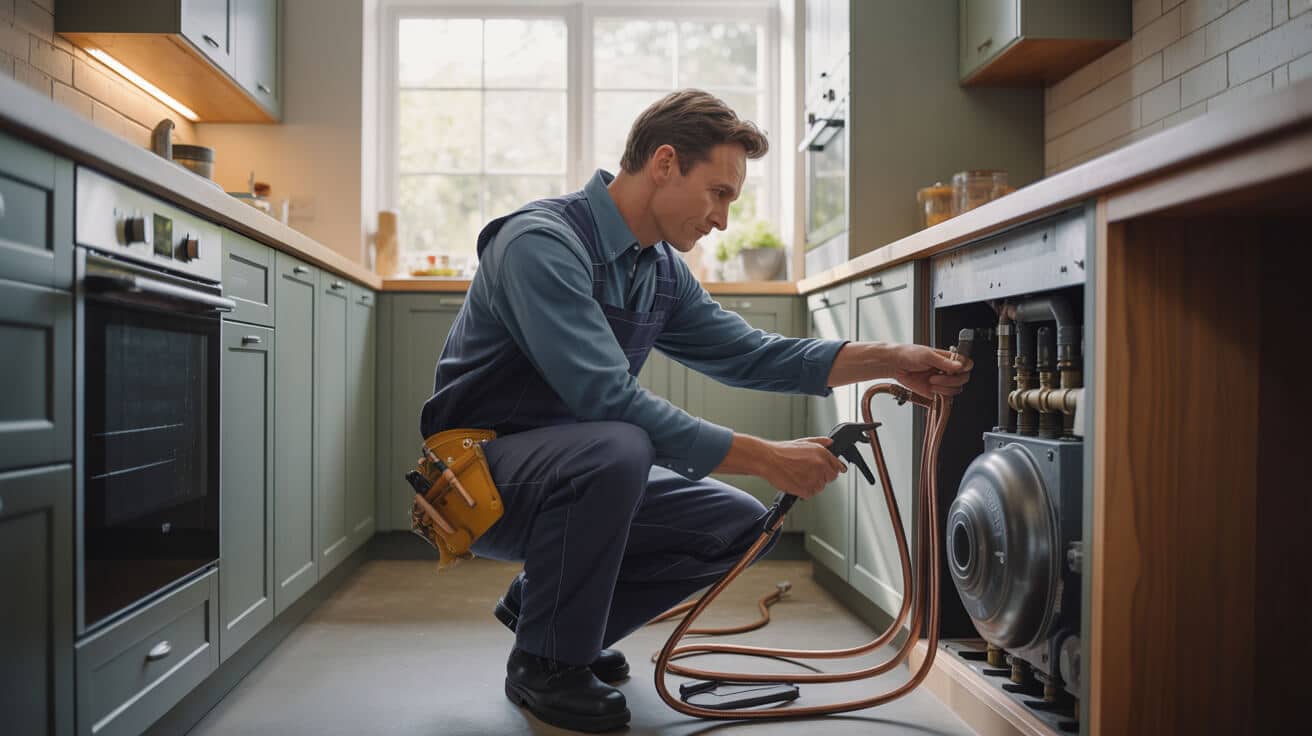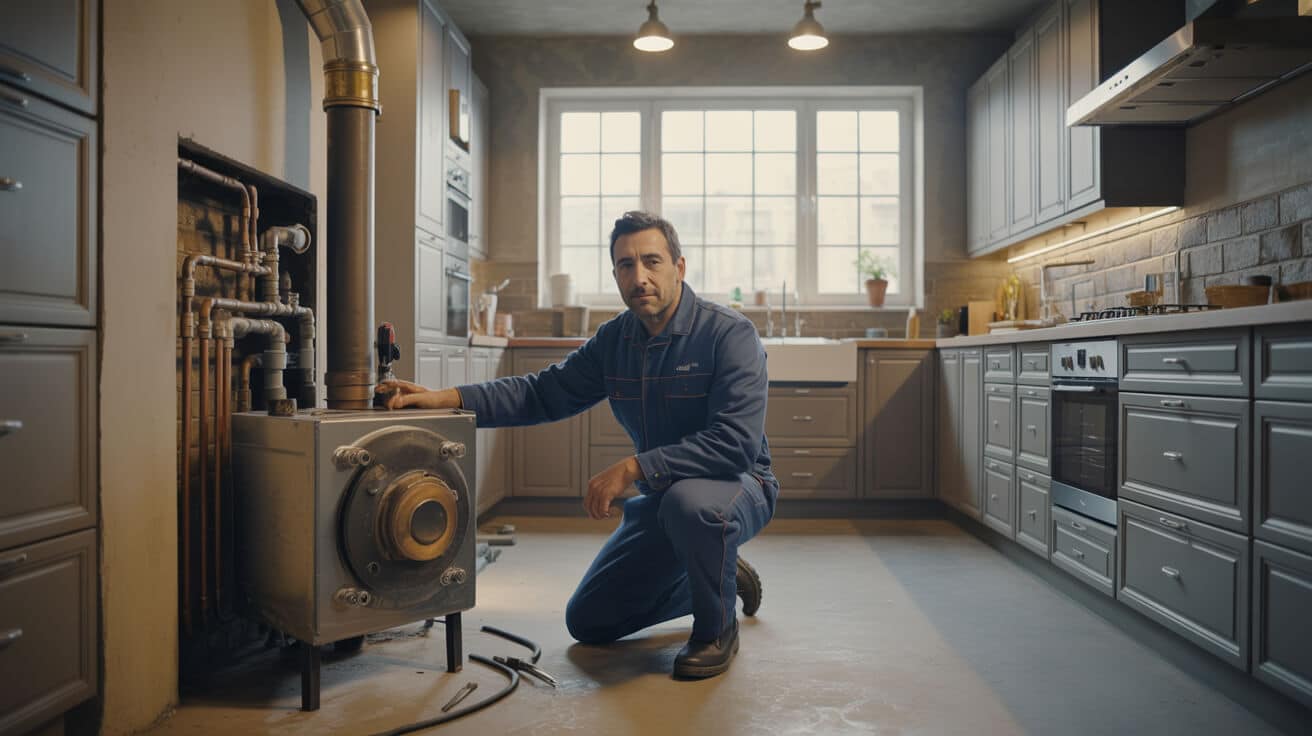Modernising domestic or commercial heating through old boiler replacement affects comfort, operational risk, and overall property value. This multifaceted process is increasingly mandated by shifting regulatory frameworks, the pursuit of efficiency, and heightened awareness of environmental and tenant welfare. Plumbers 4U facilitates seamless transitions for property owners, managers, and organisations by combining technical skill, compliance rigour, and end-to-end service delivery.
Etymology or name origin
“Boiler” derives from early industrial vessels designed to heat water or generate steam, essential for distributing warmth in living and working spaces. “Replacement” designates the substitution of obsolete or underperforming systems, necessitated by evolving standards or system ageing. The joined term focuses on the systematic renewal of heating infrastructure rather than reactive repair.
Overview and context
Heating system renewal is catalysed by a convergence of factors:
- Regulatory pressure to uphold minimum efficiency (notably, Building Regulations Part L and Boiler Plus).
- Escalating repair frequency and rising utility bills.
- User expectations for comfort, reliability, and control.
- Market incentives such as grants or energy-saving schemes available in your region.
Properties most exposed to outdated or non-conforming boilers include older single-family homes, apartment blocks, and managed housing portfolios. Organisations and building users seek to reduce operational uncertainty, anticipate compliance deadlines, and improve the occupant experience. Replacement offers distinct benefits over piecemeal repairs: improved safety, consistent performance, and alignment with long-term asset management strategies. For business or rental settings, replacement affects both liability and reputational standing.
History
Origins
Early fixed heating systems were rudimentary, relying on fireplaces and open stoves unable to deliver consistent or safely distributed heat. The first true boiler systems emerged in the 19th century, adapting industrial steam and water technologies for domestic application.
Industrial emergence
Widespread adoption of piped heating in the 20th century paralleled advances in fuel infrastructure, notably natural gas. Early domestic boilers featured open-flue combustion and limited control interfaces. Installations focused on supplying hot water and space heating, with reliability and convenience soon prompting the standardisation of residential boilers.
Contemporary evolution
Growing focus on fuel scarcity and emissions in the latter 20th century spurred a wave of new legislation. Requirements for sealed systems, high-efficiency condensing technology, and programmable controls have become central. Digital control interfaces, connectivity to energy management systems, and renewable-ready design features now allow heating assets to meet evolving performance and compliance benchmarks. Organisations like Plumbers 4U have augmented traditional services to meet new technical, safety, and reporting expectations.

Principles, components, and processes
Phases of replacement
Initial survey and diagnosis
A certified engineer—often Gas Safe or OFTEC registered—assesses your system for reliability, output, controls, fuel type, and regulatory status. For large portfolios or commercial premises, digital surveys may streamline the process across multiple properties.
Specification and project planning
Refined heat-loss calculations match new equipment to demand profiles, avoiding both over- and under-sizing. Quotations detail total costs, required adaptations, and recommended ancillary upgrades (e.g., magnetic philtres, thermostat upgrades, weather compensation).
Disconnection and system isolation
Technical teams ensure gas, water, and power supplies are made safe. Old units are removed with environmental and regulatory protocols observed, sometimes including asbestos or hazardous material management.
Installation and system integration
New boilers, controls, and ancillary components are installed and adapted to existing pipework layouts. Modern installations support zoning, smart connectivity, and, if specified, compatibility with renewable technologies. System protection includes flushing, inhibitor dosing, and upgrade of shutting valves and expansion vessels for sealed systems.
Commissioning, certification, and documentation
Final checks span combustion analysis, pressure testing, system balancing, and digital control configuration. Professional teams complete mandated paperwork: Benchmark logbook, Building Control notification, warranty registration, and—for landlords—CP12 Gas Safety Certificates.
User handover and aftercare
Comprehensive orientation gives you the knowledge to control, maintain, and optimise the new system. Service reminders, access to emergency response, and digital monitoring are increasingly common value additions.
Component evolution
- Early units: Open-flue combustion, no modulation, minimal insulation.
- Modern units: Sealed, condensing, modulating burners; robust casing; smart control integration.
- Ancillary upgrades: smart thermostats, zone valves, TRVs (thermostatic radiator valves), system philtres, and weather compensation devices.
Functionality, purpose, and applications
Replacement restores and enhances the intended functions of heating systems, delivering:
- Stable, comfortable environments for living, working, or learning.
- Reduced risk of safety incidents (carbon monoxide, leaks, combustion hazards).
- Predictable energy costs and streamlined maintenance cycles.
- Pathways for your organisation to pass audits and avoid reputational or financial penalties.
Applications include:
- Individual homes: Prioritising occupant safety, cost control, and convenience.
- Rental properties: Meeting EPC (Energy Performance Certificate) and annual safety standards; addressing compliance for tenants.
- Commercial settings: Maintaining large heating plants or distributed system assets; ensuring uptime for business continuity.
- Facility portfolios: Asset lifecycle planning, grant eligibility, and bulk modernization to meet regulatory cycles.
Classifications, types, and variants
By fuel
- Gas-fired: Most prevalent in urban and suburban contexts; efficient, with modern units supporting hydrogen-mix fuels.
- Oil-fired: Common in rural or off-grid settings; installations subject to OFTEC standards.
- LPG: Alternative for properties without natural gas access; requires distinct tank storage and burner setups.
- Electric: Applicable in decarbonization initiatives or restricted spaces where combustion-based systems are impractical.
By system
| Boiler Type | Water Heating | Space Heating | Typical Controls | Typical Use Cases |
|---|---|---|---|---|
| Combi | Instant, on-demand | Yes | Digital, smart | Flats, small homes |
| System | Cylinder-fed | Yes | Zoned, programmable | Family homes, multi-bath |
| Regular | Cylinder/open tank | Yes | Mechanical, basic | Larger properties, heritage |
By installation context
- Like-for-like swaps vs. conversions (e.g., system-to-combi)
- Block upgrade vs. single-unit
- Retrofitting in heritage/restored buildings vs. new builds
Systems, tools, and methodologies
Diagnostic workflows
- Infrared thermography and digital pressure loggers
- Gas analyzers for combustion compliance
- hydraulic balancing and flow testing equipment
Removal and preparation
- Pipework cutting devices (manual or press-fit)
- Safe lifting/handling equipment for restricted access
- Asbestos identification and abatement protocols
Installation tools
- power flush systems for cleaning pipework
- Calibrated digital tools for control integration
- Smart control programming units
Maintenance and protection
- System philtres (magnetic/chemical)
- Inhibitor dosing for corrosion prevention
- Remote diagnostics for ongoing monitoring (where available)

Stakeholders and entities involved
- Installer: Must hold current credentials (Gas Safe, OFTEC, etc.), ensures technical accuracy at each stage.
- Client (you): Initiates or authorises works, reviews proposals, manages property access.
- Manufacturer: Defines warranty and post-installation support; may provide direct digital monitoring on advanced units.
- Compliance/certification authorities: Audit installations, manage reporting to regulatory bodies, and issue completion certificates.
- Property/facilities manager: Coordinates large or complex projects, maintains documentation, and interfaces with organisational leadership.
Plumbers 4U orchestrates communication between all participants, overseeing scheduling, documentation, and the sequencing of teams for complex retrofits or high-stakes properties.
Legal, regulatory, and ethical considerations
Building Regulations
Boiler replacements must comply with Part L (fuel efficiency), with mandatory notification to Building Control. Failure to notify or certify can invalidate insurance or expose you to fines.
Boiler Plus legislation
Requires new installations to employ advanced controls (e.g., timer, thermostat, load/compensation modulating controls), measurable efficiency standards, and—often—documentation of compliance steps.
Safety and professional standards
Only Gas Safe registered engineers (or OFTEC for oil systems) are authorised to conduct gas or oil-based replacement. Maintenance and documentation, including the provision of a completed Benchmark log and CP12 certificate (if you let property), are strictly required.
EPC and MEES
Landlords face additional hurdles: Minimum Energy Efficiency Standards mandate EPC ratings above E (UK) for lettings. Replacement is one of the most effective pathways to raise a property’s score. Non-compliance can affect rental income and marketability.
Ethical commitments
Transparent quotations, honest assessment of need versus repair, and full documentation underpin your safety and financial security—as well as the professional reputation of service providers. Plumbers 4U’s procedural framework emphasises risk mitigation, clarity, and compliance at each phase.
Performance metrics, data, and measurements
Energy efficiency
- Seasonal efficiency: Condensing Boilers routinely achieve 90–97% efficiency compared to pre-2005 units’ 60–75%.
- Emissions: New installations consistently reduce both carbon dioxide and nitrogen oxides, with a growing focus on air quality impacts in urban zones.
- Bills: Migration from a legacy system to a modern, well-sized boiler may offer reductions in your annual fuel expenditure of 10–30%, subject to insulation and occupancy factors.
Reliability and warranties
- Modern units demonstrate lower mean time between failure (MTBF) and commonly include warranties ranging from 5 to 12 years.
- Ancillary system upgrades (philtres, new controls, zoning) further protect system performance and longevity.
Control and maintenance
- Digital, programmable, and smart controls allow minute-by-minute optimization, enhancing comfort and uncovering energy savings.
- Remote diagnostics, where available, support preemptive maintenance, reducing the frequency and cost of unscheduled visits.
| Metric | Pre-Upgrade Legacy | Modern Replacement |
|---|---|---|
| Certified efficiency | 60–75% | 90–97% (condensing) |
| Average warranty | 2–3 years | 5–12 years |
| CO₂ emissions (kg/year) | 3,000–5,000+ | 1,700–2,700 |
| Breakdowns/year | 1–2 | <0.5 |
Challenges, barriers, and limitations
Technical
- Legacy properties may pose installation hurdles: tight plant rooms, archaic wiring, or incompatible radiators.
- Blocked or non-compliant flue routes, concealed pipework, or hazardous building materials (asbestos).
- In balconies or shared spaces, external access and legal permissions add complexity.
Economic and logistical
- High upfront costs or complex funding application processes may delay works.
- Qualified installer availability can fluctuate regionally, with peaks during heating season.
- Disruption to normal operations or living arrangements, especially in rental and multi-unit buildings.
- Navigating evolving legislation, especially when managing multiple holdings or pursuing grant funding.
- Tenant or occupant communication and support during works, especially where long-term disruption is anticipated.
- Balancing rapid decarbonization with increased demand for electric grid capacity and infrastructure.
Impact, influence, and legacy
Heating system modernization generates durable benefits for property owners, managers, and organisations. Replacing a legacy boiler with a modern unit enhances resilience to regulatory change, increases the perceived and actual value of property, and reduces exposure to compliance and reputational risk. Quantifiable improvements in safety, comfort, and operational cost are enhanced by indirect advantages, including increased market appeal, reduced frequency of emergency interventions, and greater comfort for you, your tenants, or your staff.
For larger housing providers or commercial operators, coordinated upgrades support grant access, lower insurance premiums, and future-proof assets against forthcoming regulation.
Future directions, cultural relevance, and design discourse
Emerging technologies suggest a future where heating systems are seamlessly integrated with home or building networks, leverage predictive diagnostics, and adapt to hybrid or zero-carbon fuel sources. Legislative tightening will likely eliminate sub-E-rated rentals and enforce smart- or digital-control adoption as standard. Interest in environmental, social, and governance (ESG) metrics is shaping organisational and investment priorities, making quantifiable heating performance a core property management concern. Plumbers 4U continues to evolve service modalities, offering consultative, turn-key solutions that support compliance, comfort, and lower-carbon living. As perceptions of heat move from utilitarian to strategic, narrative shifts towards safe, transparent, and high-performance service delivery are becoming central to property and organisational identity.

